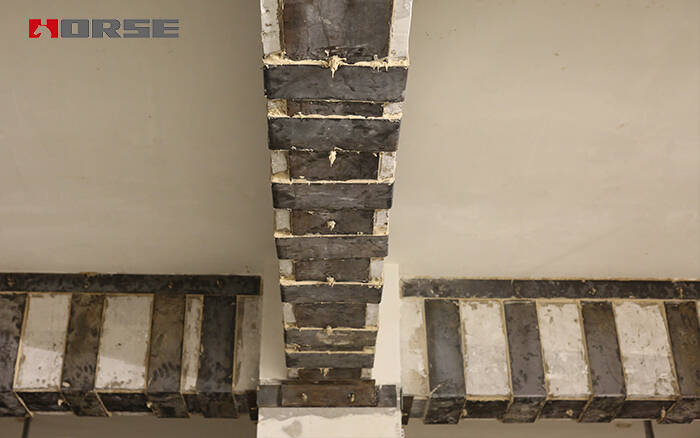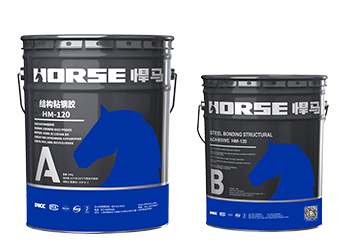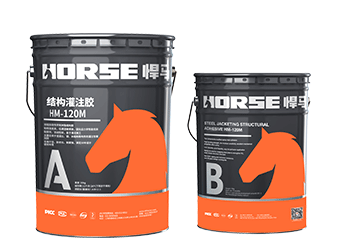Solutions
Horse Construction offers full range of structural strengthening materials with technical supports, documentation supports, products supports, project supports.
Elementary analysis on the key points of concrete beam bonding steel reinforcement construction

At present, the commonly used reinforcement method for concrete beams in China is the bonding steel reinforcement method. The comprehensive application of such measures as sticking steel plates, sticking U-shaped hoop plates, planting negative bending moment stiffeners, and planting bolts fixes the quality defects caused by insufficient negative bending moment bearing capacity at the beam support.
1 Method characteristics
1) The steel plate is bonded to the surface of the concrete member with a high-performance epoxy adhesive. The steel plate and the concrete work together as a unified whole, and the good tensile strength of the steel plate is used to achieve the purpose of enhancing the bearing capacity and rigidity of the component.
2) Paste the steel plate on the side of the upper mouth of the beam. The steel plate is bonded to the surface of the concrete member with a high-performance structural adhesive, so that the steel plate and the concrete form a unified whole. The good tensile strength of steel plate is used to achieve the purpose of enhancing the negative moment bearing capacity and rigidity of reinforced concrete beams. In order to make the steel plate and the original concrete beam better integrate the force, the bolt position is determined at the intersection of the steel plate on the upper side of the beam and the U-shaped stirrup on the bottom side of the beam by means of bolt planting. The bolts are implanted into the beam with special planting glue, and the exposed ends of the bolts are tightened with nuts to strengthen the integrity of the beam. Because the steel plate cannot pass through the lower end of the reinforced concrete beam support, the negative bending moment stiffener is planted there. Holes are drilled on both sides of the beam, and negative moments are implanted to strengthen steel bars. Connect the protruding parts at both ends to the steel plate to strengthen the integrity. Improve the load-bearing capacity of the beam at the support of the negative bending moment.
2 Construction process
Positioning and laying-off a concrete beam unloading a beam base treatment-crack repair and sealing-drilling-cleaning-steel plate production and cutting-steel plate drilling-bonding.
3 operating process points
3.1 Manufacturing and processing of reinforcement materials
1) The steel plate for reinforcement is cut according to the model and size required by the design. When cutting, it must be cold cut, not hot cut, to prevent deformation of the steel and internal stress. If the length and width of the steel parts cannot meet the design requirements, welding can be used, and the welded steel parts should be leveled and shaped on the platform or smoother ground
2) The U-shaped hoop plate is simmered at the intersection with the steel plate used for reinforcement on the upper side of the beam according to the design size.
3) The negative bending moment stiffeners are cut according to the designed specifications and dimensions, and the anchoring screw adopts the finished full-filament screw, which is cut according to the designed size after entering the field.
4) Punch holes on the steel plate and U-shaped hoop according to the design size and position. The hole diameter must meet the design requirements.
3.2 Derusting. Polished
1) Steel plates and U-shaped hoop plates should be polished with a grinder for rust removal and rough treatment according to their corrosion conditions, so that the greater the metal luster and roughness of the steel plate, the better, and the grinding lines should be as perpendicular to the force direction as possible. Wipe the surface with absorbent cotton dipped in acetone, and set aside after it is completely dry.
2) Reinforcing ribs and screws are marked at the corresponding positions according to the design requirements. Mark the length range of the rust removal and cleaning, use a grinder or a wire brush to polish the surface of the steel bars within the rust removal cleaning length range until metallic luster, and use absorbent cotton dipped in acetone to wipe the surface of the steel bars within the rust removal cleaning length range.

3.3 Unloading
During construction, jacks, deflection meters and their supporting systems are used as supporting systems. The deflection value and the bidirectional control parameter of the jack force value are used as the basis for unloading. Flatten and fix the root and top of the support column, and the jack applies force to align the support column with the fulcrum. During construction, if the deflection meter shows a hidden number or the jack pressure value changes significantly, the work should be stopped. Construction can only be continued after confirming safety and stable support. The unloading of multiple jacks should be synchronized.
3.4 Grassroots treatment of concrete components
The unevenness of the beam base surface in the reinforced area is smoothed with an angle grinder to remove surface scum, oil and other impurities until the new surface of the structure is completely exposed. And use an air compressor to blow the dust clean until the dust does not stick to the touch. The corner paste should be chamfered and polished into an arc shape, and the arc radius should not be less than 20mm.
3.5 Sealing of cracks in concrete components
According to the design requirements, the cracks of the concrete components are sealed and the joints are sealed with the structural glue. Before grouting, use compressed air to clean the pores and cracks. According to the size of the crack area, single-hole grouting or multi-hole grouting can be used. Grouting on a crack can be done from one end to the other. When grouting, the turning mantle: valve should be closed immediately when the next exhaust nozzle comes out of grout. In this order, the grouting pressure of the chemical grout is 0.2 MPa. The pressure should gradually increase. To prevent sudden pressure, after reaching the specified pressure, the pressure should be kept stable to meet the grouting requirements.
3.6 Planting negative bending moment stiffeners
Insert the processed steel bar into the hole first, and seal both ends of the hole with epoxy mortar. When plugging, leave a glue injection hole at one end, and leave a vent hole on the other end. After the epoxy mortar has solidified, the high-pressure glue injection can be carried out. Put the prepared anchor glue into the glue cylinder and install the glue nozzle. Inject the anchoring glue into the hole through the glue injection hole. Until the glue overflows from the vent on the other end. Then, use epoxy mortar or other materials to plug the injection hole and the vent hole. After inserting the rebar, the screw should be kept still until the planting rebar glue is solidified to avoid the influence of external force. Set up warning boards at appropriate locations to prevent the glue from being bumped or moved before curing.
3.7 Plant bolts
Use a special glue gun to inject glue. The injection tube of the glue gun should be inserted into the bottom of the hole to start injecting glue, pulling out while injecting. The amount of glue injection should be based on a little overflow after inserting the bolt rod. Generally, it is 2/3 of the hole depth. Insert the processed bolt rod slowly into the hole. When inserting, rotate the screw in the same direction while slowly inserting the screw. It should be inserted once until it reaches the bottom of the hole. If necessary, knock the end of the exposed screw with a hammer to ensure that the screw is fully inserted. At this time, if there is no anchoring glue overflowing from the hole, it means that the amount of glue injected is not enough. The screw must be pulled out, re-injected, and inserted again until the glue can overflow the hole.
3.8 Steel plate bonding
1) Steel plate pasting and pressurization: After the steel plate is stuck, it should be clamped immediately with a special U-shaped clamp and properly pressurized so that the glue is just extruded from the edge of the steel plate. After the U-shaped hoop is pasted, the pre-implanted bolts and nuts are tightened as a permanent additional anchoring measure for the steel plate.
2) Curing: The structural adhesive is cured at room temperature. More than 90% of the strength value can be reached within 24 hours. At this time, the fixture or support can be removed. It can be cured completely within 72 hours and can be used under force. If the temperature is lower than 5°C, manual heating should be used. Infrared lamps or electric blankets should be used for heating and insulation. The curing period should not cause any disturbance to the steel plate.
3.9 Bonding of steel U-shaped hoop
When pasting the steel plate, it should be pasted from the middle of the bottom of the beam to both sides to avoid voids during the application of T to affect the reinforcement effect, so that the U-shaped steel plate is closely combined with the working surface. After the U-shaped steel plate is bonded, the pre-implanted bolts and nuts should be tightened immediately as a permanent additional anchoring measure for the steel plate
3.10 Anticorrosive painting
After reinforcement, the surface of the steel plate should be painted with cement mortar for protection. If the surface area of the steel plate is large, in order to facilitate the mortar bonding, a layer of lead wire mesh or a layer of pebbles can be glued, and then the surface is protected with 20mm thick Ml5 cement mortar to avoid corrosion of the steel.
You can find anything here you are in need of, have a trust trying on these products, you will find the big difference after that.

High strength carbon fiber reinforced polymer (CFRP) strip / laminate / plate for structural strengthening and concrete repair

Two-component epoxy modified epoxy structural strengthening adhesive for bonded steel plate to concrete

Modified epoxy resin structural perfusion adhesive, specifically for supporting adhesive bonded steel reinforcement